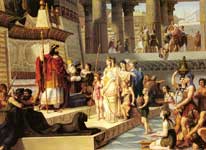Paintings

Solomon And The Queen Of Sheba
Giovanni Demin (1789 - 1859) Italian Painter
Giovanni De Min (sometimes spelled Demin, Belluno, October 24, 1786 - Tarzo, November 23, 1859) was an Italian painter and engraver.
Biography
He came from a modest family: his father Joseph was a tanner, and his mother Lucia Schiochet was home to John Mary Hill, the local lord and professor at the University of Padua.
He was a pupil of the engraver Paolo Filippi, noting their quality early in 1803 started the Academy in Venice, where, together with Francesco Hayez, became a pupil of the Tuscan painter Theodore Matteini.
From 1808 to 1817, always with the Hayez, was sent to Rome by Leopold Cicognara, dean of the Academy, a retired three years to perfect their art. Here he met Canova becoming valuable contributor. [1]
In 1817 he returned to Veneto where he left several works (often large) theme is religious, and mythological.
The neoclassical influence of Canova is expressed by De Min mainly through the fresco, as can be seen in the works of 1837 at Villa Gera at Conegliano. In his early work shows the painter is measured and well-connected to the master's style, but the later works are more dramatic, inspired by the paintings of David.
He is buried in the cathedral of Ceneda.
Notes
^ "The Muse", De Agostini, Novara, 1965, Vol.IV, pag.147
References
Giovanni De Min - Treccani
Paludetti Giovanni Giovanni De Min: 1786-1859, Udine 1959.
Federico Piscopo, Giovanni De Min Crespano painter in the piedmont and the time of Bishop Sartori Canova, Crespano del Grappa 2009.
